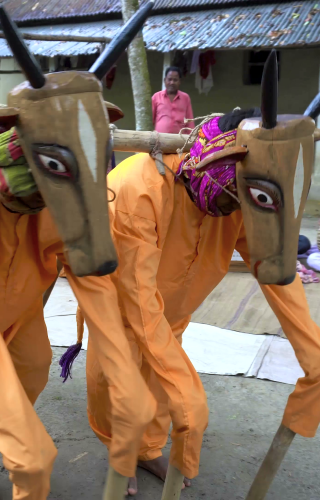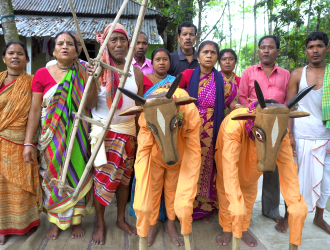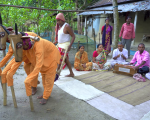This photoessay chronicles the performance of Halua Haluani (halua means farmer and haluani his wife) along with some other khon performances that aided government campaigns and schemes. Halua Haluani captures the struggles of a rural household and the miseries of a farmer’s life, and provides a commentary on oppressive social practices. The khon is at times performed with performers wearing the famed wooden mukhas (masks) of Kushmandi which got a G.I tag in 2018. Halua Haluani is generally performed during the harvesting season, prior to Monosha Puja and at the end of each performance, the performers go to different households to collect food grains. In Dakshin Dinajpur, Halua Haluani is also known as the bo khela, which essentially means a performance carrying the social message of a symbol used in the play, the farmer’s plough in this case.
The musical instruments that are commonly used in Halua Haluani are dhol, kartal (a percussion instrument), flute and harmonium. The artists do not have written scripts for their performances, they frame the basic structure of the play around daily events, while most of the dialogues are articulated at the spur of the moment. The play usually depicts an episode from the domestic lives of the farmers and presents their daily tribulations in a tragicomic manner. The farmer goes to the field without his plough and is reminded of his folly by a passer-by; he waits for his wife to bring him lunch, but she turns up quite late; the rustic domesticity changes its hues into a darker tone as this protagonist, burdened with debt, is forced to marry off his underaged daughter to a much older man.
Halua Haluani got nominated to be a part of Mukha Mela organised by Mahishbathan Gramin Hastashilpa Samabay Samity Limited in collaboration with the rural crafts hubs of the Government of West Bengal and UNESCO. Mukha Mela celebrates the art of wooden mask making of the Rajbanshi community in Dakshin Dinajpur, and Halua Haluani, because of its use of masks, became an obvious choice for the event.















